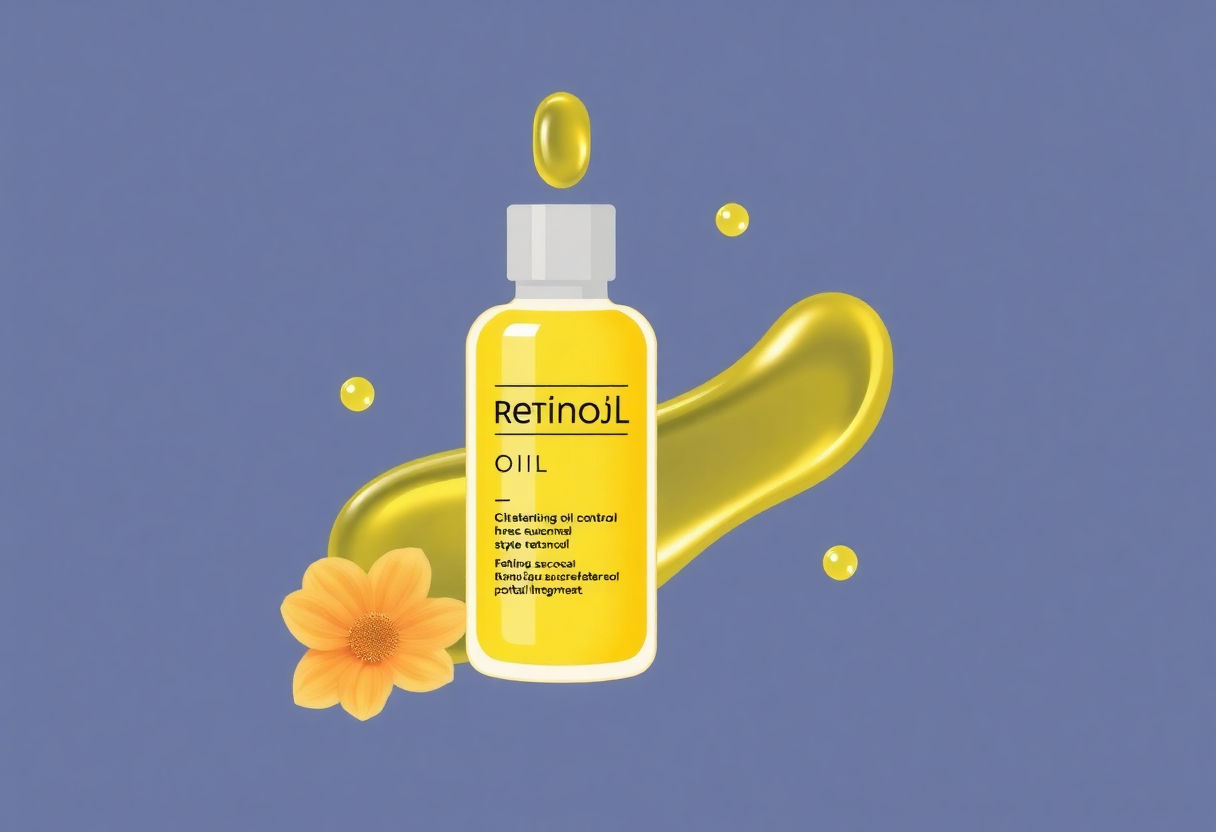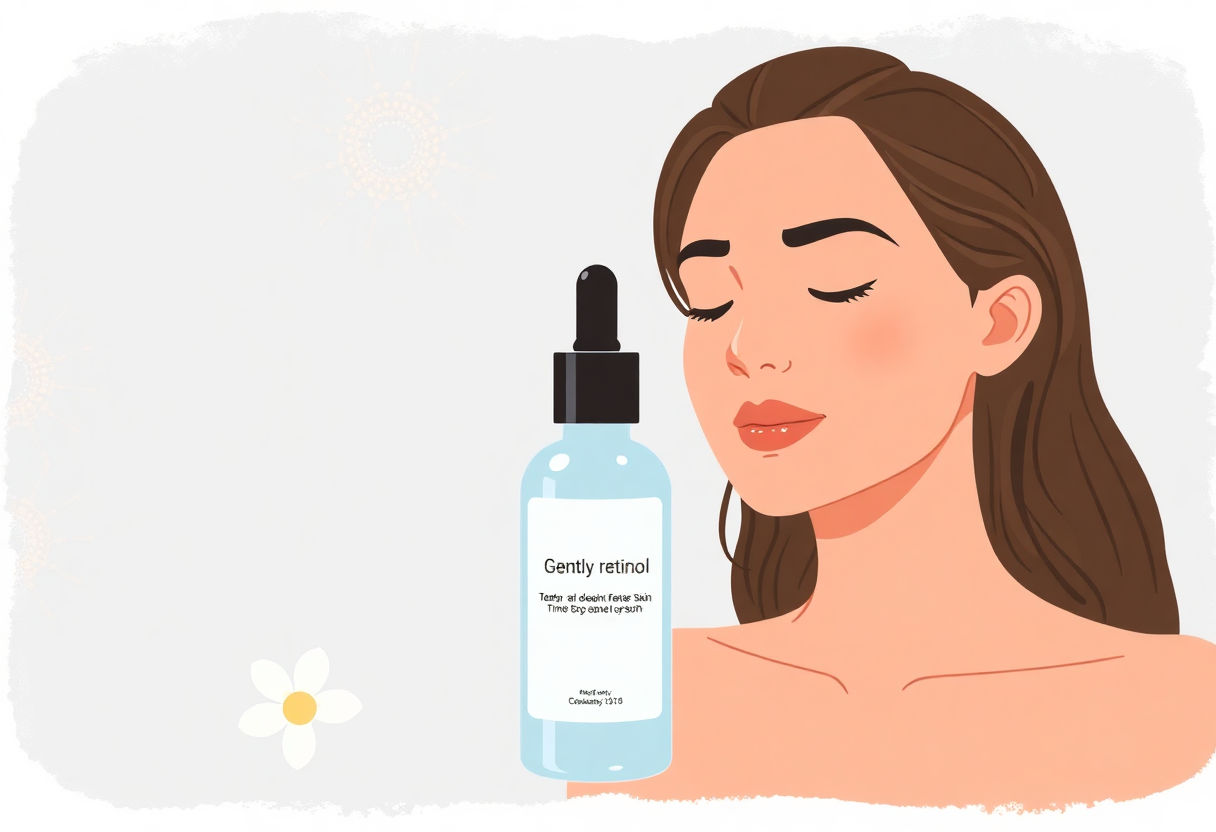The transformative power of retinol makes it a must-have in any skincare regimen, renowned for its exceptional ability to improve skin texture and address age-related concerns. Tailored to suit diverse skin types, retinol’s benefits extend to enhancing moisture balance for dry skin, controlling excess oil in oily complexions, and soothing sensitive skin. This article will guide you through selecting the best body retinol products, ensuring that each choice complements your unique skin needs. As you explore the nuanced application techniques and effective practices, you’ll discover how to achieve radiant, healthy skin. Dive in to unlock the secrets of this skincare marvel.
Key Takeaways
- Retinol is a versatile skincare ingredient known for its ability to improve skin texture and promote healthy cell turnover, suitable for various skin types.
- Selecting the right retinol product involves understanding your skin’s unique needs and choosing formulations designed for specific conditions like dryness, oiliness, or sensitivity.
- Proper application techniques are crucial to achieving optimal results and minimizing potential side effects associated with retinol use.
- Awareness of common side effects and knowing how to mitigate them can enhance your retinol experience and ensure safety.
- Integrating retinol effectively into your routine with best practices leads to noticeable improvements in skin health and appearance over time.
Understanding Retinol
 Retinol, a derivative of vitamin A, is renowned for its transformative effects on the skin, making it a popular ingredient in skincare products. Its primary role involves accelerating skin cell turnover, which is essential for maintaining youthful and radiant skin. This process effectively reduces the appearance of fine lines and wrinkles, giving the skin a smoother texture.
Retinol, a derivative of vitamin A, is renowned for its transformative effects on the skin, making it a popular ingredient in skincare products. Its primary role involves accelerating skin cell turnover, which is essential for maintaining youthful and radiant skin. This process effectively reduces the appearance of fine lines and wrinkles, giving the skin a smoother texture.
One of the major benefits of retinol is its ability to enhance collagen production. Collagen, a structural protein, is crucial for skin elasticity and firmness. With continued use, retinol can visibly firm the skin, contributing to a more youthful appearance. Furthermore, retinol’s ability to regulate sebum production makes it a powerful ally for those with acne-prone skin. By preventing clogged pores, it reduces breakouts and clears existing acne, leading to clearer, healthier skin.
Retinol is also celebrated for its role in fading hyperpigmentation and evening out skin tone, thanks to its exfoliating qualities that promote an even dispersion of melanin. This characteristic makes it particularly beneficial for individuals seeking to diminish the appearance of age spots or sun damage.
It is important to note that while retinol offers remarkable benefits, its potency requires careful formulation. Products are crafted to suit different skin types, with some incorporating hydrating agents to balance retinol’s drying effects. As a result, retinol emerges as a versatile ingredient suitable for a wide range of skincare needs, from anti-aging to acne control. Understanding these attributes allows individuals to select retinol products best suited to their specific skin concerns.
Retinol for Dry Skin
 For individuals with dry skin, choosing the right retinol formulation is crucial to maintaining a healthy and hydrated complexion while benefiting from the anti-aging properties of this powerful ingredient. Dry skin naturally lacks moisture, rendering it more prone to irritation and flakiness. Therefore, selecting a gentle retinol formulation is imperative to prevent exacerbation of these conditions.
For individuals with dry skin, choosing the right retinol formulation is crucial to maintaining a healthy and hydrated complexion while benefiting from the anti-aging properties of this powerful ingredient. Dry skin naturally lacks moisture, rendering it more prone to irritation and flakiness. Therefore, selecting a gentle retinol formulation is imperative to prevent exacerbation of these conditions.
One effective strategy is to opt for encapsulated retinol, which releases the active ingredient slowly, ensuring a prolonged yet less irritating effect. Additionally, integrating hydrating ingredients such as hyaluronic acid, glycerin, or ceramides into the retinol product can bolster hydration levels. Many formulations now combine these ingredients with retinol to create a nourishing blend that supports dry skin types.
A hallmark of incorporating retinol for dry skin is a gradual introduction. Begin applying the retinol product one to two times a week, and gradually increase the frequency as the skin builds tolerance. Using retinol at night allows the skin to heal and renew itself during its natural regenerative cycle.
Moisturization is also pivotal in this regimen. A thick, emollient-rich moisturizer should follow retinol application to lock in moisture and act as a barrier against potential dryness. Some dermatologists recommend “sandwiching” retinol, applying a moisturizer before and after retinol application, to add an extra layer of protection and hydration.
This careful integration of retinol can help maximize its benefits for dry skin, reducing the appearance of fine lines and promoting a smoother, more radiant appearance without forsaking skin hydration.
Retinol for Oily Skin
 For individuals with oily skin, retinol can serve as an exceptional ally in balancing oil production and addressing common skin concerns such as acne. Oily skin often results from overactive sebaceous glands, leading to excess sebum that can clog pores and trigger breakouts. Retinol, a derivative of vitamin A, penetrates the skin’s surface and revitalizes cellular turnover, effectively reducing oiliness and minimizing acne.
For individuals with oily skin, retinol can serve as an exceptional ally in balancing oil production and addressing common skin concerns such as acne. Oily skin often results from overactive sebaceous glands, leading to excess sebum that can clog pores and trigger breakouts. Retinol, a derivative of vitamin A, penetrates the skin’s surface and revitalizes cellular turnover, effectively reducing oiliness and minimizing acne.
When selecting a retinol product for oily skin, it’s crucial to opt for formulations that contain non-comedogenic ingredients to prevent pore congestion. Lightweight serums or gels are often preferable as they can deliver potent active ingredients without contributing to an oily residue. Incorporating retinol into your routine can also help diminish the appearance of enlarged pores and acne scars through skin renewal processes.
Key considerations for those with oily skin include beginning with a low concentration of retinol to allow the skin to acclimate, thereby reducing the risk of irritation. Gradually increasing the concentration over time can help achieve optimal results. Consistency in application is important, ideally integrating retinol in the evening to leverage its regenerating properties overnight.
Additionally, pairing retinol with complementary ingredients such as salicylic acid can further enhance its efficiency in controlling oil production and improving skin texture. This combination can be particularly beneficial for individuals struggling with persistent acne and shine throughout the day. With the right formulation and regimen, oily skin can experience significant improvements, balancing the skin’s natural oils and promoting a clearer, more refined complexion.
Retinol for Sensitive Skin
 For individuals with sensitive skin, incorporating retinol into their skincare routine requires a delicate approach. It’s essential to choose formulations specifically designed to minimize irritation while still delivering desirable results. Retinol is well-known for its ability to enhance skin texture, reduce the appearance of fine lines, and even out skin tone. However, those with sensitive skin might experience heightened reactions if the product is too potent.
For individuals with sensitive skin, incorporating retinol into their skincare routine requires a delicate approach. It’s essential to choose formulations specifically designed to minimize irritation while still delivering desirable results. Retinol is well-known for its ability to enhance skin texture, reduce the appearance of fine lines, and even out skin tone. However, those with sensitive skin might experience heightened reactions if the product is too potent.
Mild Formulations Are Key
- Look for retinol products labeled as “sensitive skin” or “gentle.”
- Low-retinol concentration is advisable, typically starting at 0.25% or lower.
- Consider creams with encapsulated retinol, which offers a sustained release, reducing immediate irritation.
Incorporating Moisture & Barrier Support
Sensitive skin benefits from formulations that include hydrating and soothing ingredients alongside retinol. Seek out products containing:
- Hyaluronic acid for moisture retention.
- Ceramides to support the skin barrier.
- Aloe vera or oat extracts for calming effects.
Patch Test and Gradual Introduction
Before applying any retinol product extensively, a patch test on a small skin area is prudent. Start by using the product twice a week, gradually increasing frequency as the skin builds tolerance.
Supportive Skincare Routine
Pair retinol with a gentle cleanser and a rich, fragrance-free moisturizer. Incorporate sun protection into your daily routine to prevent sensitivity exacerbated by UV exposure.
Adopting these strategies can help harness the benefits of retinol without overwhelming sensitive skin, paving the way for a smoother, more radiant complexion.
Retinol for Combination Skin
 To find the best retinol products for combination skin, it’s essential to recognize the unique needs of this skin type. Combination skin features both oily areas, typically the T-zone, and dry patches elsewhere. The goal is to select a retinol product adaptable enough to address these varying needs effectively.
To find the best retinol products for combination skin, it’s essential to recognize the unique needs of this skin type. Combination skin features both oily areas, typically the T-zone, and dry patches elsewhere. The goal is to select a retinol product adaptable enough to address these varying needs effectively.
When choosing a retinol product, consider the following tips:
-
Lightweight Formulations: Opt for retinol products with a lightweight, gel-based formulation. These provide necessary moisture to dry areas without overwhelming oily zones.
-
Controlled-Release Technology: Look for products that incorporate controlled-release technology, which gradually delivers retinol to the skin. This feature minimizes potential irritation and balances the effects across different skin areas.
-
Hydration and Soothing Ingredients: Products containing hydrating agents such as hyaluronic acid and soothing botanicals like chamomile can help maintain moisture in dry areas while minimizing irritation often experienced on more sensitive skin parts.
-
Customizable Strengths: Begin with a lower-strength retinol to gauge your skin’s response. You can gradually increase to a higher potency based on your skin’s tolerance and specific needs.
A dermatologist once explained, “The key to managing combination skin is to use targeted treatments that adapt to your skin’s dual nature without exacerbating any particular area.” This approach ensures that you leverage retinol’s benefits while maintaining the health of both your oily and dry skin areas.
Managing combination skin with retinol is about finding balance—a balance that aligns with your unique skin characteristics and provides consistent, overall skin health improvements.
Tips for Applying Body Retinol
To ensure optimal results when using body retinol, it is crucial to apply it correctly. Retinol has the potential to significantly improve skin texture and tone, but improper application can lead to unwanted effects such as dryness or irritation. Here are some essential tips to help you make the most of your body retinol usage:
-
Start Slowly: If you’re new to retinol, introduce it gradually into your regimen. Begin with applications once or twice weekly to allow your skin to adjust. As tolerance builds, you can increase the frequency according to your skin’s response.
-
Choose the Right Time: Retinol can make your skin more sensitive to sunlight, so it is best applied in the evening. This not only minimizes sun exposure but also complements your skin’s natural reparative cycle during the night.
-
Apply to Clean, Dry Skin: For maximum efficacy, apply retinol on clean, dry skin approximately 20-30 minutes after showering. This ensures that the product can penetrate your skin more effectively without interference from moisture.
-
Use a Moisturizer: To counteract potential dryness, follow up with a rich, fragrance-free moisturizer. This step will help to lock in moisture and soothe the skin, making the transition to retinol usage more comfortable.
-
Avoid Sensitive Areas: Be cautious around areas of the skin that are more sensitive, such as the neck or chest, unless specifically directed by a dermatologist.
-
Monitor and Adjust: Pay close attention to how your skin reacts to retinol. Should you notice excessive dryness or irritation, consider reducing the frequency of application or consulting with a skincare professional.
By adhering to these guidelines, you can harness the transformative power of retinol while minimizing adverse effects.
Common Side Effects of Retinol
Retinol is widely acclaimed for its transformative effects on the skin, yet it is crucial to be aware of common side effects that may accompany its use. Understanding these side effects allows individuals to better integrate retinol into their skincare routines while minimizing discomfort.
Initial Irritation and Redness: A typical reaction to retinol is initial irritation, characterized by redness and slight discomfort. This occurs as the skin adjusts to the new ingredient. To mitigate this, it is advisable to gradually introduce retinol into your regimen, starting with a lower concentration and increasing as tolerated.
Dryness and Peeling: As retinol accelerates cell turnover, some users may experience dryness and peeling. This side effect is generally temporary and can be alleviated by moisturizing adequately and selecting hydrating formulations that include humectants like hyaluronic acid.
Photosensitivity: Retinol can make the skin more sensitive to sunlight, leading to an increased risk of sunburn. It is essential to apply sunscreen daily and avoid excessive sun exposure, especially during peak hours, to protect the skin adequately.
Changes in Skin Texture: Some users report a temporary roughening of skin texture as new skin cells come to the surface. This can usually be resolved with regular exfoliation and consistent use of nourishing products to support skin recovery.
Further, those with sensitive skin may find that using retinol less frequently or opting for products specifically formulated for sensitivity reduces adverse reactions. Consulting a dermatologist can provide personalized guidance, ensuring the benefits of retinol are maximized without compromising skin health.
Best Practices for Retinol Use
When incorporating retinol into your skincare routine, adhering to best practices is crucial to achieve optimal results while minimizing potential irritation. Begin with a low concentration of retinol, especially if you are new to this ingredient, to allow your skin to gradually adjust. As your skin builds tolerance, you can progressively increase the concentration over time to enhance benefits.
Apply retinol products at night since retinol may increase the skin’s sensitivity to sunlight. Use a broad-spectrum sunscreen during daytime hours to protect against UV damage. It’s important to apply retinol to clean, dry skin, ensuring that your skin is free from any remaining makeup, oils, or dirt, which can interfere with its absorption.
Incorporate moisturizers into your routine to help alleviate potential dryness or peeling, common side effects when using retinol. Choose a hydrating product that complements your skin type without causing additional irritation or acne.
Patience is key as retinol can take several weeks or even months to demonstrate visible improvements. Applying it inconsistently may not yield the desired outcomes, so aim for a regular regimen.
Keep in mind retinol can react negatively with certain ingredients like vitamin C, benzoyl peroxide, or AHAs, potentially causing irritation. It’s advisable to separate their usage by applying them at different times of the day or rotating their use on different days.
Lastly, if you encounter persistent redness, peeling, or irritation, it may be beneficial to consult with a dermatologist. They can provide tailored advice and suggest adjustments that align with your specific skin needs.
Conclusion
In conclusion, retinol serves as a versatile ally for achieving healthier and more radiant skin, suitable for various skin types. By understanding its benefits and selecting the right formulation, whether you have dry, oily, sensitive, or combination skin, you can enhance your skincare routine effectively. As you integrate retinol into your regimen, remember that consistent application and awareness of your skin’s response are crucial. Looking ahead, the ongoing research and development of retinol products promise even more tailored solutions, ensuring everyone finds an ideal match for their unique skin needs. Embrace the journey towards a revitalized and youthful complexion.
Frequently Asked Questions
How often should I use body retinol products for optimal results?
For most users, applying body retinol products two to three times per week is recommended initially. Adjust the frequency as your skin builds tolerance, aiming for every other day or daily use, depending on skin sensitivity and product instructions.
Can I use retinol if I have sensitive skin?
Yes, it is possible to use retinol products for sensitive skin by choosing formulations specifically designed for sensitivity. Begin with a lower concentration and gradually increase usage as your skin adapts, ensuring minimal irritation.
When can I expect to see results from using body retinol?
Visible improvements vary, but typically you may start noticing smoother and more radiant skin within 4 to 12 weeks. Consistent use is key to achieving more significant changes.
Are there any side effects to using retinol, and how can they be minimized?
Common side effects include dryness, redness, and peeling. To minimize these, start with products that have lower retinol concentrations, integrate them slowly into your routine, and always follow up with a moisturizer.
Can I use retinol products during the day?
Retinol products are generally recommended for nighttime use, as they can increase skin’s sensitivity to sunlight. If you use them during the day, ensure you apply a broad-spectrum sunscreen of SPF 30 or higher.
